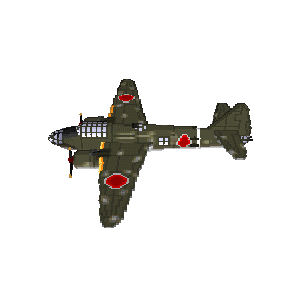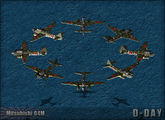Difference between revisions of "Mitsubishi G4M"
From D-day: wiki
(Created page with "{{Unitinfo | image=Mitsubishi G4M | type=Transport | owner=Japan | year= | length= | width= | height= | weight= | speed= ...") |
m |
||
| (3 intermediate revisions by 2 users not shown) | |||
| Line 18: | Line 18: | ||
|title=History | |title=History | ||
|content= | |content= | ||
| + | |||
| + | The Mitsubishi G4M was the result of an Japanese Navy specification for a long range bomber that would have a range of over 4,800km. Originally Mitsubishi wanted to design a large four engined aircraft to fulfill this role, but the navy insisted on a smaller two engined plane. To achieve the required long range with only two engines the design had to be extremely light and use large fuel tanks, this meant that the G4M was unarmoured, was equipped with a limited defensive armament and had very vulnerable fuel tanks. Much to the enjoyment of Allied fighter pilots that nicknamed it the "the one-shot lighter". However the aircraft's long range was extremely useful in the vast Pacific ocean where the G4M performed many successful long range bombing missions during the early stages of the war. Later in the war they were one of the few aircraft that were able to counterattack the American bases from which the [[Boeing B-29 Superfortress|B-29 Superfortress]] were operating. | ||
==References== | ==References== | ||
| − | *[] | + | *[http://en.wikipedia.org/wiki/Mitsubishi_G4M Wikipedia] |
| + | }} | ||
| + | |||
| + | |||
| + | {{Timeframe | ||
| + | |||
| + | |midwar=yes | ||
| + | |latewar=yes | ||
| + | |||
}} | }} | ||
| Line 30: | Line 40: | ||
image:g4m.jpg{{!}} | image:g4m.jpg{{!}} | ||
}} | }} | ||
| + | |||
| + | |||
| + | {{Box | ||
| + | |title=Comments | ||
| + | |content= | ||
| + | |||
| + | <comments voting="Plus" /> | ||
| + | |||
| + | }} | ||
| + | |||
{{JapanNav}} | {{JapanNav}} | ||
Latest revision as of 11:18, 23 January 2015
| ||||||||||||||||
History
The Mitsubishi G4M was the result of an Japanese Navy specification for a long range bomber that would have a range of over 4,800km. Originally Mitsubishi wanted to design a large four engined aircraft to fulfill this role, but the navy insisted on a smaller two engined plane. To achieve the required long range with only two engines the design had to be extremely light and use large fuel tanks, this meant that the G4M was unarmoured, was equipped with a limited defensive armament and had very vulnerable fuel tanks. Much to the enjoyment of Allied fighter pilots that nicknamed it the "the one-shot lighter". However the aircraft's long range was extremely useful in the vast Pacific ocean where the G4M performed many successful long range bombing missions during the early stages of the war. Later in the war they were one of the few aircraft that were able to counterattack the American bases from which the B-29 Superfortress were operating.
References
. . . .
Time Frames
| 1930 - 1940: Pre-War |
1940 - 1942: Early-War |
1942 - 1944: Mid-War |
1944 - 1945: Late-War |
1945 - 1960: Post-War |
1930 - 1960: Total-War |
|
| Buildable | Yes | Yes | ||||
| Bonus Crate |
. . . .
Comments
. . . .


Enable comment auto-refresher